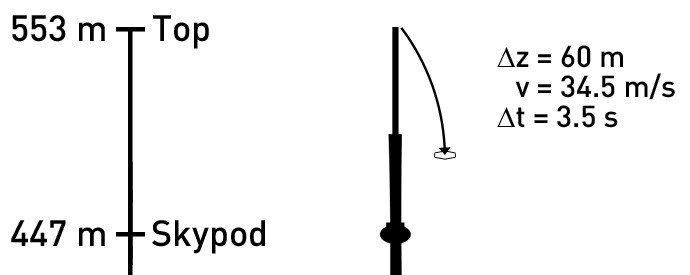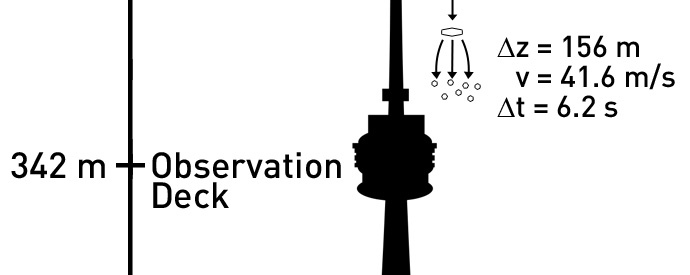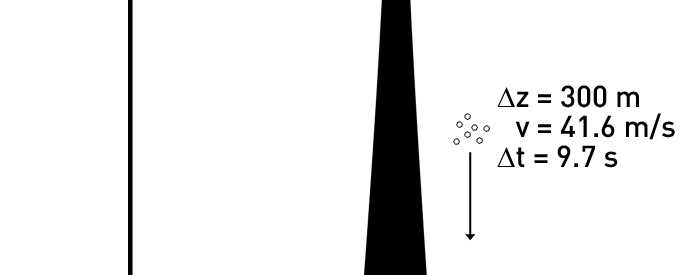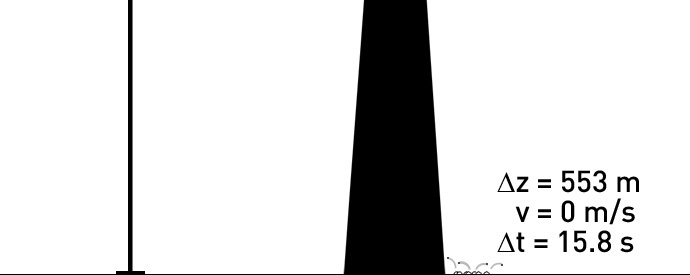100-pound ice chunk clings to CN Tower, we do damage math
Meteorologist/Science Writer
Thursday, April 19, 2018, 6:46 PM - After April's ice storm, which impacted nearly all of southern Ontario, downtown Toronto became a hazard zone due to the threat of falling ice. Here's the science behind the dangers of falling ice.
By now, word has spread far and wide about the damage done to the roof of the Rogers Centre, due to a chunk of ice falling off the CN Tower on Monday. According to police, as of Thursday morning, the CN Tower and Ripley's Aquarium remain closed, as well as Bremner Blvd, from Rees St. over to Lower Simcoe St., and the John St Extension over the tracks, with limited access to the Rogers Centre, for the safety of pedestrians and drivers.
The major concern now, apparently, is a large chunk of ice still clinging to the Tower, which they say could weight up to 100 pounds.
What kind of damage could a chunk of ice that size cause?
First, how big is a 100 pound chunk of ice? With a mass of roughly 45 kilograms, and the density of ice being 917 kilograms per cubic metre, we're looking at 0.05 cubic metres of ice, or 50,000 cubic centimetres. That would give us a sheet of ice 10 cm thick, and about 70 cm on a side. These dimensions could vary quite a bit, though, depending on the thickness of the ice, but we'll work with those given, for this example.
If a sheet of ice of that size - 10 cm x 70 cm x 70 cm - falls from the top of the CN Tower, it would only take about 3.5 seconds for it to reach terminal velocity - the point at which its downward acceleration is balanced by the upward force of air resistance - of about 34.5 metres per second, and it would have fallen roughly 60 metres.

A brittle sheet of ice of that size wouldn't stay intact for long, though. With air resistance pulling at its edges and pushing against the underside, the ice would shatter, breaking down into fragments as small as 10 centimetre cubes, or about the same dimensions as softball-sized hail (but much denser than your average hailstone).

Fragments of this smaller size aren't affected by air resistance as much as the larger sheet of ice, so it would take less than a second for them to accelerate to their new terminal velocity of 41.6 m/s. By this time, ice would only have been falling for just over 6 seconds, and would have only covered just over one-quarter of their journey towards the ground.
From here, at this new terminal velocity, they would continue to fall at that same speed, possibly jostling about amongst each other, smacking into the tower observation deck or the tower pillar (producing even more smaller fragments).

Sticking with our ice chunks that are 10 cm on a side, after nearly 10 seconds of falling, they would still have more than 250 metres left to go in their fall.

Reaching the ground, the ice chunks would have been falling for nearly 16 seconds, covering a total of 553 metres from the tip of the tower, and their velocity would very quickly change from 41.6 m/s to zero.
How hard would they hit, though?
Just before impact, each ice chunk - with a mass of just under one kilogram - would have a Kinetic Energy of nearly 800 Joules (K.E. = 1/2*mass*velocity^2), and once the impact happens, that kinetic energy is converted to potential energy.
Their impact force - the part that tells us exactly how much damage they would do - comes from setting the amount of Work that the ice does (Work is the Force applied over a distance, or Work = Force*distance), equal to the amount of Potential Energy (P.E. = mass*acceleration*height) the ice has. Under ideal conditions, if there was no air resistance, we would use the simplest set of values to calculate this - the mass * the acceleration due to gravity * the height the ice fell (W = F*d = PE = m*g*h). However, air resistance takes quite a bit out of the ice chunks on their way down. (Seriously, the Potential Energy from this, without air resistance, is somewhere around 5,000 Joules!)
With air resistance factored in, we're limited to the 800 J from the Kinetic Energy, and we equate this to the Work done (W = PE = KE = 1/2*mass*velocity^2 ~ 800 J = F*d). To find the Force from this, we divide the energy of 800 J by the chunk's stopping distance, d, and stopping distance is highly dependent on what the ice chunk hits.
If it hits a hard surface, such as concrete, the chunk of ice will compress so much that its stopping distance can be taken as the full thickness of the chunk, so 10 centimetres. With 800 Joules of energy, this results in an impact force (F = 800 J / 0.1 m) of 8,000 Newtons. Most of that force goes directly into dramatically shattering the ice.
If the ice chunk hits something notably softer though, such as a person, the ice undergoes very little compression and, as a result, the stopping distance is substantially shorter - more like 1 centimetre, or even less. Thus, the amount of impact force suddenly jumps by a factor of 10, at least, up to 80,000 Newtons!
Even 8,000 N of impact force is enough to cause serious injury, such as broken bones or a concussion. When the impact force is more like 80,000 N, it could easily kill someone.
As noted above, all of these calculations depend on the size of the ice, and is thickness. So, smaller pieces of ice would, of course, result in lower impact forces. However, we have already seen the dramatic results of some of the ice falling, as the chunk of ice that broke through the roof of the Rogers Centre managed to punch through corrogated steel, and just look at the damage done to other nearby buildings.
Bottom line: Look up and watch out, and stay away from the CN Tower for now!



